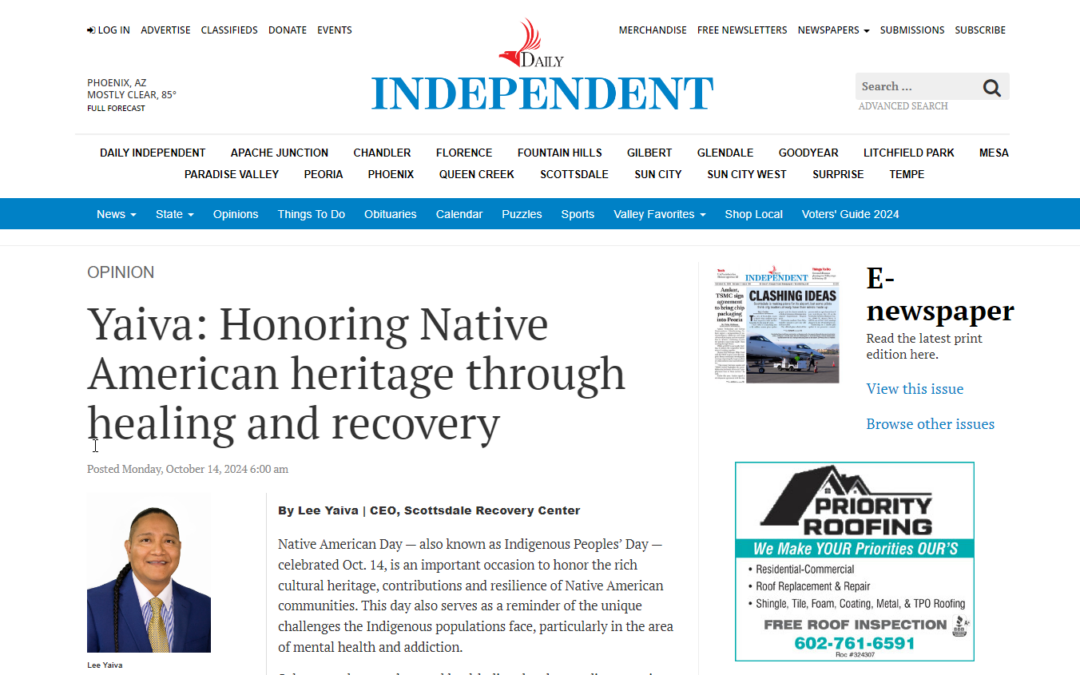Native American Day — also known as Indigenous Peoples’ Day — celebrated Oct. 14, is an important occasion to honor the rich cultural heritage, contributions and resilience of Native American communities. This day also serves as a reminder of the unique challenges the Indigenous populations face, particularly in the area of mental health and addiction.
Substance abuse and mental health disorders have a disproportionate impact on Native American and Alaska Native communities. According to the data, the rates of substance abuse among Native Americans are generally much higher than those of the general U.S. population.
Factors such as historical trauma, socio-economic disparities and limited access to culturally appropriate healthcare services contribute to these challenges. Native communities often face barriers like geographic isolation, limited access to health care facilities and a shortage of culturally sensitive treatment programs, making it difficult to seek help. That is why it is so important to offer a unique and cultural approach to recovery.
A deeply rooted tradition of healing
Indigenous cultures have long emphasized the importance of holistic well-being, integrating physical, mental and spiritual health. For many, healing ceremonies, sweat lodges and the use of holistic medicines like sage and sweetgrass are integral to restoring balance in life.
Native American medicine has been evolving for over 40,000 years across more than 500 nations. The core principles of traditional native medicine emphasize maintaining a balance between nature and health. For centuries, Native communities have relied on naturopathic medicines and remedies to promote the well-being of their people.
Cultural perspectives on health and recovery
For many communities, health and wellness are seen as a balance among several aspects of life: emotional, spiritual, physical and mental. Unlike Western medicine, which often focuses on treating symptoms, traditional healing practices seek to understand the root causes of illness and imbalance, emphasizing prevention, community support and spiritual guidance.
This holistic perspective influences how these communities view recovery from drug and alcohol addiction, placing a significant focus on reconnecting with cultural values, traditions, and community ties.
Unique challenges in addiction recovery
Native Americans often face a set of unique challenges when it comes to addiction recovery. Statistics indicate that some of these communities experience some of the highest rates of substance use disorder in the U.S.
These high rates are often attributed to factors such as historical trauma, socioeconomic disparities and a loss of cultural identity. Generations of oppression, forced relocation and the disruption of traditional ways of life have deeply impacted these communities, leaving some individuals more vulnerable to substance use disorders.
Furthermore, mainstream recovery programs are frequently based on Western methodologies, which may not resonate with the values and beliefs central to these cultures. Concepts of individualism, often embedded in Western recovery programs, may clash with the communal focus integral to many of these traditions. As a result, individuals from these cultural backgrounds may feel disconnected or alienated by conventional treatment options.
Traditional healing practices for recovery
In various cultural traditions, traditional healing practices play a critical role in recovery from substance use disorder. These practices not only address the physical aspects of addiction but also focus on spiritual and emotional healing.
1. Sweat lodges: Used as a form of spiritual cleansing, sweat lodges help individuals purge toxins, both physical and spiritual. The ceremony encourages self-reflection, prayer, and a sense of renewal, providing a communal space for healing and recovery.
2. Talking circles: These gatherings offer a supportive environment where individuals can share their experiences without fear of judgment. Talking circles emphasize the importance of community and serve as a reminder that recovery is not an isolated journey but one that involves family, friends and community members.
3. Use of sacred medicines: Plants such as sage, cedar, sweetgrass and tobacco are often used in healing rituals to promote clarity, cleansing and protection. These plants are considered sacred and are used in a variety of ways, including smudging, as part of ceremonies, or as offerings to spirits.
4. Ceremonial practices: Ceremonies like the Sun Dance or the Vision Quest play a central role in healing practices. These ceremonies are a time for spiritual reflection, reconnection with one’s heritage and seeking guidance on one’s journey of healing.
5. Connection with nature: Many recovery programs rooted in these cultural practices incorporate time spent in nature, recognizing that a connection to the earth is essential for restoring balance and healing. Spending time outdoors, walking in the forest, or engaging in traditional agricultural practices can be deeply healing for individuals in recovery.

